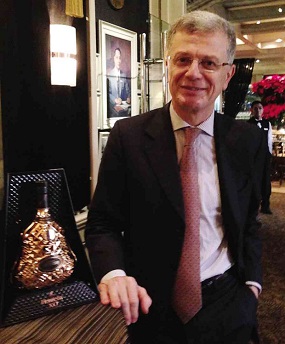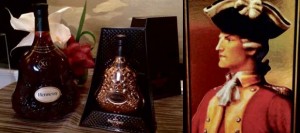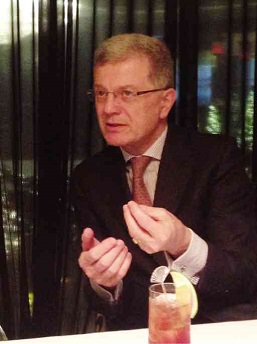When Bernard Peillon, chair and chief executive officer of Hennessy Cognac, speaks about this premium French cognac house, he beams with pride talking about a 250-year legacy of producing top-quality liquor and having the largest and most expensive inventory of aging cognac in the planet.
He refers to a luxury beverage giant that has honed expertise across seven generations of distilling, blending and aging cognac in a way that sounds more like an art form than an industrial enterprise.
Hennessy is to date the world’s leading cognac brand and the second biggest in the vast portfolio of French luxury goods conglomerate LVMH Moët Hennessy Louis Vuitton S.A.—next only to fashion house Louis Vuitton. Being part of a global group with about 60 brands catering to the discerning market, Hennessy could only welcome rising wealth in markets outside of its storied European homebase.
And while Hennessy continues to age its vast inventory of eaux-de-vie (French for “water of life”), the brandy produced by fermentation and double distillation, some of which for a century or more, its game plan looks at a span of many generations ahead. Part of the strategy is to expand its client base not just in terms of geography but in demographics. This means attracting young adults, many of whom are in the Asia-Pacific.
Peillon, who became Hennessy CEO in 2007, visited the Philippines for the first time late last year, recognizing potential for greater business in this market given increasing consumer affluence in Southeast Asia’s fastest-growing economy. For Hennessy, its Philippine business is—at least for now—not as big as that in Malaysia or even Vietnam (where the company, however, had an edge as Vietnam was a former French colony), but it’s bigger than in Poland and looking very promising.
“In the next five years and beyond that, we have strong ambition for development, particularly in the Philippines,” Peillon says in an interview with local media. “The perspective is extremely positive, which is in sync with the development of Philippine middle class, the development of Philippine economy.”
The Hennessy chief says he didn’t realize that the Philippines was now growing at a pace almost similar to China’s and in a low-inflation regime at that.
“In our portfolio presence, emphasizing to recruit younger consumer to our brand franchise is a way to project Hennessy into the future. Everything that we do is not for tomorrow, but how we ensure our future,” he says.
In Hennessy, blend average age is 50 years, which meant that when this house buys supply of cognac eaux de vie, it will have to look at the business at least 50 years ahead in mind.
“We are not FMCG (fast moving consumer good) company obsessed with quarterly performance. We’re obsessed with the idea of transmission; I am part of the history of Hennessy and our duty is to ensure that tomorrow we’ll be stronger than today. That’s our obsession,” he says.
The bid to make more in roads into a market with a strong potential is part of this preparation for the future.
“We need to focus on Philippines, put proper resources to prepare for tomorrow,” he says, citing similar expansion in other markets like the Middle East, Caribbean, Russia or Central Europe. “Philippines is part of that agenda to ensure the future.”
That the Philippines seems to be more of a beer-drinking country, especially among young people, is not something that bothers the Hennessy chief. “At least, it indicates an openness to drink alcoholic beverages, although beer is not as strong as other spirits,” he says. But with the vibrant nightlife in Philippine urban hubs and an increasing propensity for young Filipinos to prowl trendy bars, Peillon says it’s an opportunity to expose them to the Hennessy experience.
Through its global musical campaign “Hennessy Artistry,” for instance, Peillon says it’s a way to create such experience and expose younger consumers to Hennessy as a brand. In the Philippines, such a Hennessy Artistry exclusive party—which promotes the art of mixing music genres and drinks—was held last Jan. 24 at the Samsung Hall of SM Aura, featuring Australian singer-songswriter Timomatic, US-based DJ duo Kimkat, Filipino indie band Urbandub, DJ-drummer combo Motherbass, DJ Jessica Milner and Filipina vocalist Nicole Asensio.
Hennessy Artistry is also a way for the cognac house to change the common perception that this iconic beverage is only good for drinking on the rocks. This cognac can also be mixed with ginger ale or cranberry or other blends to create delightful cocktails.
In recent years, Hennessy has indeed won over younger consumers using music and has made cultural inroads particularly into the rap and hip-hop genres. American rapper Mac Dre, a big fan of this liquor, mentioned the brand in some of his songs and some other big and rising artists have done the same.
In the US, its single biggest market in terms of volume, Hennessy has tapped Filipino boxing champ Manny Pacquiao as a brand ambassador. Pacquiao appears in Hennessy TV, billboard and print ads along with the brand tagline: “Never Stop, Never Settle.” As a human being striving all his life, Pacquiao is a “fantastic ambassador,” the Hennessy chief says.
“Manny embodies this inner drive of pushing to be better and higher, not just being better boxer from where he was born to becoming the greatest boxer and a statesman. And from US perspective and Filipino community, his power and charisma are incredible,” he says.
Unfortunately for onshore Filipinos, these ads can not be shown locally as based on existing agreements, they can only be used to promote Hennessy in the US.
Illustrious House
Hennessy’s premium market positioning is borne out of a distillery history that’s entwined with European aristocracy.
The Hennessy cognac distillery was founded in 1765 by Richard Hennessy, an Irish officer (who later on earned French citizenship) who served in the army of Louis XV. In 1794, the house expanded business to the “New World” that is America.
In 1817, the Prince of Wales (later King George IV of Great Britain) who was a great connoisseur of cognac asked Hennessy to create a “very superior old pale cognac.” Since then, the initials V.S.O.P—Very Superior Old Pale—have been used as a benchmark for the entire industry. In 1818, the house entered Russia as Empress Maria Federovna asked Maison Hennessy to produce “the most exceptional cognac” as a birthday present for her son Czar Alexander I. Thus was how the imperial family of Russia became regular customers.
Hennessy first shipped to China in 1859 and was then one of the prestigious ambassador of French culture in the Orient. In 1865, his great-grandson Maurice Hennessy decided to create a cognac classification using varying numbers of stars to designate different quality, giving rise to Hennessy’s Three Star Cognac, today known as V.S. (Very Special). Soon this classification was adopted by the entire industry. In 1870, Maurice created the X.O. (Extra Old) classification of cognac. Originally for family and friends, X.O. is today a worldwide reference for cognacs.
Inspired by the cognac Hennessy created for Czar Alexander I in 1818, Master Blender Yann Fillioux created Paradis Imperial in 2011. This cognac features a large proportion of eaux de vie from the Maison’s 19th and 20th century reserve, creating a cognac of exceptional elegance, finesse and stature. It is packaged in an elegant crystal decanter designed by Stephanie Balini and features an 18-carat gold plated label.
In 1971, Hennessy merged with champagne house Moet & Chandon which in turn merged with fashion house Louis Vuitton in 1987, forming the Paris-based global luxury conglomerate that is LVMH.
For Hennessy, which produces only out of Cognac, France, production starts with the tedious grapevine selection. Grown in its vineyards is Ugni Blanc, the light fruity grape specially suited to double distillation in great copper stills. To ensure the aromas will be both excellent and varied, only eaux de vie from the four great crus of the region—Grande Champagne, Petite Champagne, Borderies and Fins Bois—are selected for its cognac production.
“When we age our cognac which we call eaux de vie, we blend them, like the 1900 harvest aging in old barrels,” Peillon says. When it’s been decided that the aging potential had been optimized, the liquor is then transferred from wood barrel into glass jars and enter into Hennessy’s library of old eaux de vie, some of which date back to the 1800s. Once transferred into glass, the cognac no longer ages.
In the Hennessy cellars, over 300,000 casks hewn from over 100-year-old oak trees, exclusively from French forests, stand in a dim light infused with heavy notes. Once at the top of their potential, they are put in large wicker-encased glass demijohns to preserve their qualities and afterwards used to create the rarest cognacs.
Global roadmap
“So the XO will not change significantly unless you expose it to light. You can still enjoy it five years, 10 years down the road,” Peillon says, with a caveat that he won’t recommend this route. “We recommend that you enjoy it as you buy it because aging has already been done.”
China’s rise as an economic superpower, Peillon says, has made Hennessy rethink about its global expansion strategy. For all its synonymity to opulence, snobbery is not the way to grow even as it has established itself as the benchmark of excellence in the world of cognacs.
“We’re not interested in just one market. That’s a clear point in the way we look at our world. We do not put our eggs in one basket. We know that the world will shift and market will shift in dynamics. We are ensuring the longevity of Hennessy by not just focusing on one market or one region. We spread internationally. We’re happy to see big markets, middle markets, smaller markets, emerging markets,” he says, adding that the Philippines was thus part of this global roadmap.
In the Philippines, Hennessy’s VS bottle is retailing starting at P1,400 and the VSOP at P2,500. Its XO retails at between P5,000 and P6,000. Based on online prices, the Paradis Imperial is worth a hefty £1,475 (P108,000).
To think about a cognac that used eaux de vie that aged long as 100 years, Peillon says, it’s worth to think that four generations of people have touched them for the blend that people were enjoying today. Yet, he emphasizes that Hennessy is a “contemporary” brand, one that’s “not frozen in time.”
“We want people to have the freedom to experience Hennessy at different times, different ages. As you become more mature, successful you can afford to drink it,” he says.
“The last thing we want to do is people highly respect it technically to the point that they would say, it’s for my father or grandfather, but it’s not for me. That’s the last thing I want,” he says.




